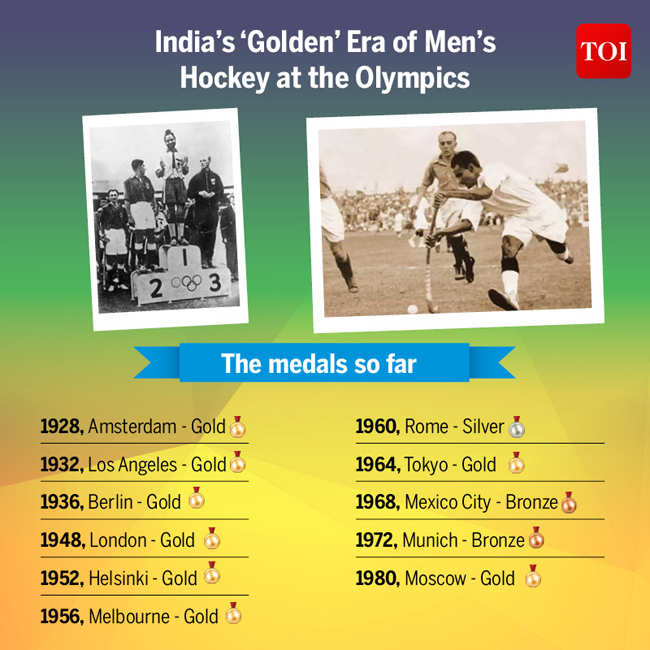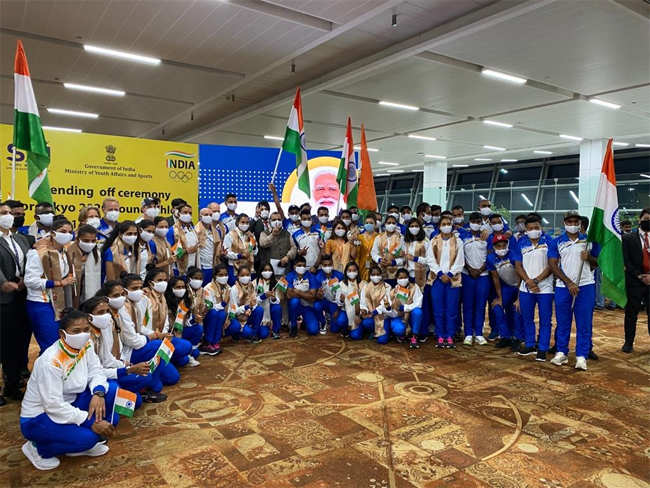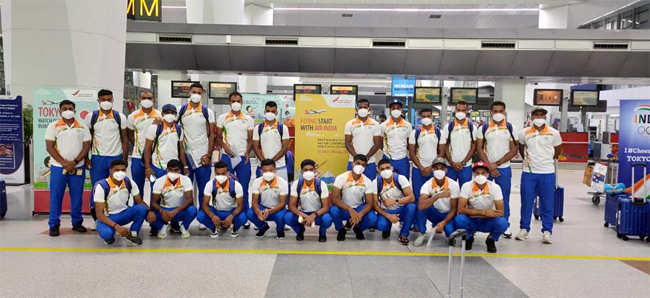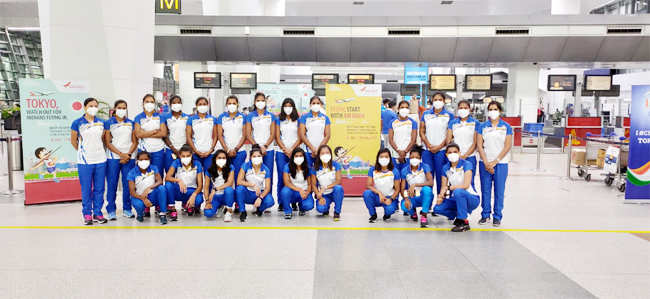Tokyo Olympics: Can Indian hockey break the Olympic medal jinx? Everything you need to know | Tokyo Olympics News – Times of India
Dr Kalra asked around for black sesame seeds and some jaggery. He melted the jaggery, added the sesame seeds to it and rolled it into tiny balls looking like medicine pills. The two players he gave the pills to came back to Dr Kalra and said: “Doc, it worked.”
The point of reference: When it comes to the big stage, staying normal and calm to get the best out of oneself can be tough. The premise of winning medals at the Tokyo Olympics won’t be any different.
The astro-turf started knocking at hockey’s door in the early ’70s. Though it took another 11 years, after the 1975 edition, before it was used at a World Cup, the 1976 Olympics hockey competition decided to debut it at the Games first.

It has since been believed that switching surfaces had a role in halting Indian hockey’s ‘Golden’ run at the Games. From 1926 to 1980, India won eight gold medals – still the highest by any hockey nation. But since the 1980 gold at the boycott-hit Moscow Olympics, India haven’t entered the semis at the Olympics. It’s been 41 years, and ‘halt’ seems a very generous word in that context.
Mark your calendars ????️Set your alarms ⏰Here’s the official schedule of the Indian Men’s and Women’s Hockey Team… https://t.co/NmtYAKILqS
— Hockey India (@TheHockeyIndia) 1626790462000
THE MEN’S TEAM
But the upswing in men’s hockey over the last decade can’t be mistaken. Coming through the ranks and with wins at the 2014 Asian Games and consecutive silver medals at the Champions Trophy (2016 and 2018), world No. 5 India will perhaps play the first Olympic Games since Sydney 2000 as genuine contenders.
“I think we have the best chance that we have had in the longest time,” former India captain Viren Rasquinha told Timesofindia.com analysing India’s chances.
“For the men’s team, I don’t think there can be a better opportunity than this, there definitely hasn’t been in the last 20 years, since the Sydney Olympics, when we just missed out on the semifinals.”

Image credit: Hockey India
A 69th-minute strike by Poland to level the game dashed India’s hopes when they needed a win to reach the semis in Sydney 2000.
In Tokyo, of the 11 other participating teams, India have beaten all but Canada in the last two years. The Indian team never got a chance to play Canada in that period.
But that’s just on paper. The fact is that India will need to get through world No. 1 Australia, defending Olympic champions Argentina, the tenacious Spain and New Zealand and the Asian Games winners and hosts Japan for a place in the quarterfinals from Pool A.
To put it in context further, at the 2017 Sultan Azlan Shah Cup in Malaysia, Japan almost had India on the ropes leading 3-2 at the end of third quarter. It needed a 58th-minute strike from Mandeep, his hat-trick goal, that pulled India back from the brink of defeat to win 4-3.
Japan have played almost with the same set of players since then, and went on to win the Asian Games gold. The Olympics at home will only add to the fire in their bellies.
India’s quarter final opponents will most likely be either world champions Belgium, European champions Netherlands, Rio 2016 bronze medallist Germany or world No. 7 Great Britain (England). Interestingly, all four contested the semifinals of the European Championships 2021.
An important inference from that statistic is that most of the leading hockey nations had top-quality competition in the run-up to the Games in Tokyo. But India’s outings, most notably being FIH Pro League wins against Argentina in Buenos Aires, have been far and few in between lockdowns, including none since the devastating second wave that hit the country in April and led to another lockdown for the team inside the Sports Authority of India centre in Bengaluru.
Amid that, and after a few intra-squad matches, coach Graham Reid announced his 16 based on four factors: (1) Stamina and fitness to counter the Tokyo heat and pressure of back-to-back games, (2) Versatility and a player’s ability to play in multiple positions, (3) Off-the-ball play, and (4) Team-first mentality.
In that process, senior forwards SV Sunil and Akashdeep Singh missed out and a young attacking line, led by Mandeep Singh and Lalit Upadhyay, was given a chance. In all, 10 players in the India squad will make their Olympic debut.

Image credit: Hockey India
“I think often people read into these selections more than what there actually is, but I don’t think it (selecting youngsters) is a matter of trying to surprise the opposition. I think it’s a mixture of things that I said before (four factors mentioned above),” India coach Graham Reid said in a conversation with TimesofIndia.com
Reid would hope his boys end up on the podium to back his process, one he put in place since he took over as coach in 2018.
“The big picture for us is that we want to be jumping onto that podium at the end of it all…If you win the quarters, anything is possible.” Reid further said.
THE WOMEN’S TEAM
Since Rani scored that goal in the second match of the double-header Olympic qualifier against USA in 2019, the women’s team has lived through hope, despair and hope again.
The first Indian women’s team to reach consecutive Olympics has been the underplayed story in Indian hockey, dominated by their male counterparts. If breaking into the top ten of world rankings (No. 9 currently) was an achievement, qualifying for the Olympics silenced any doubters that remained.
But like the men’s team, not having played enough competitive hockey heading into the Olympics didn’t add the ‘ideal’ tag to their preparations, other than a couple of exposure tours. None since April, though.
More than anything, skipper Rani’s team has to overcome the self-doubts that Indian women’s hockey comes across at every big stage. In one of her comments after returning from the Germany tour, Rani admitted that they need to stay ahead of their heavyweight opponents.

Image credit: Hockey India
“It was not easy playing the world’s two top teams (Argentina and Netherlands), who we hadn’t played against over the last few years,” Rani had told TimesofIndia.com. “So we didn’t have much idea what style of play they would bring to the pitch, as we have mostly been playing Asian teams.
“These are the teams — Argentina, Germany, Holland and so on — who when we play against, we come to know whether we have been working on the right track or not and how much more work we need to put in. We have to stay a step ahead of the top teams. Both these teams we played (Argentina and Germany) mostly play the semis of Olympics and World Cups. We don’t have that experience.” Rani had added.
At No. 9 in the world, India are the fifth best-ranked team in Pool A out of six teams.
World No. 1 Netherlands and No. 4 Germany are in India’s pool, along with defending Olympic champions Great Britain, 8th-ranked Ireland and South Africa.
Pool B consists of World No. 2 Australia, No. 3 Argentina, No. 6 New Zealand, No. 7 Spain, No. 10 China and hosts and Asian Games champions Japan.

Image credit: Hockey India
“Earlier the gap between us and the European nations seemed bigger; but now when we play them, that difference seems smaller,” said Rani. “If we continuously work on the finer details, we can beat them; they are not unbeatable.”
The team is coached by Sjoerd Marijne.
COVID-FORCED RULES
1. Alternate Players
The Sport-Specific Regulations developed by the International Olympic Committee (IOC) and international sports federations have brought in the concept of Alternate Players for team sports/events.
The IOC allows a squad of only 16 in both men’s and women’s hockey, apart from standbys. But this time, those standbys have been segregated into APs and reserves.
The hockey teams in Tokyo will have two Alternate Players and a reserve goalkeeper each apart from the 16-member squads selected. So the coaching staff will have those 16 players plus the two APs from which it can pick the 16 players available on the ground for every match.
But in case of the ‘reserve’ goalkeeper, the replacement can only be made if the first-choice goalkeeper gets injured or has a valid reason to be replaced. However, in that case, the first-choice goalkeeper can’t play in the rest of the tournament.

Image credit: Hockey India
2. During the pool stage
The International Olympic Committee and the International Hockey Federation announced:
– “In case a team or teams cannot participate in a pool match, it will be recorded as a 5-0 loss but the team will not be withdrawn from the competition. The pool rankings will be determined in the usual way, including the 5-0 loss(es) for any matches not played for this reason. The said team/teams will be allowed to play its/their remaining pool matches if they are able to.”
– “In case two teams are unable to participate in the pool match between them, the match will be recorded as a 0-0 result but no points will be awarded to either team. The teams will not be withdrawn from the competition and the pool rankings will be determined according to the Tournament Regulations. The said teams will be allowed to play their remaining pool matches if they are able to.”
– “In case one or more team(s) is unable to continue in the competition before the end of the final match in the pool stage, they will be ranked in the pool according to their results, with 5-0 losses for any matches they have not been able to compete in, but they will not be considered for progression to the knockout stage. If they are ranked in the top 4 teams, the top 4 teams not including the withdrawn team(s) will progress to the knockout stage.”
3. During the knockouts
This is what the rules state:
– “After the pool stage is complete and the quarterfinal teams confirmed, in case a team that has qualified for the quarter finals is not able to participate in a match, if time allows, the next ranked team from their pool will replace them in the quarter final. If there is not sufficient time (at the sole discretion of the FIH) their opponent will be awarded a 5-0 victory and proceed to the semifinal.”
– “If both teams due to play against each other in a quarterfinal are unable to compete, and there is insufficient time to replace them, then neither will advance to the semifinal and both teams will be ranked as if they had lost the quarterfinal.”

Image credit: Hockey India
– “In case of the semifinalists, if a team withdraws or is unable to participate prior to the match and there is sufficient time to replace them, they will be replaced by their quarterfinal opponent. If there is not sufficient time for a replacement team, then their opponent will advance to the final. They will be ranked in the competition as the losing semi-finalist and the loser of the bronze-medal match, i.e., 4th.”
– “If both teams due to play against each other in a semi-final are unable to compete, neither will advance to the final and both teams will be ranked 4th. In this case, the winner of the other semifinal will be awarded the gold medal and the loser of the other semifinal will be awarded the bronze medal.”
– “If a team withdraws or is unable to participate in the bronze-medal match, such team will not be replaced, and the remaining team is allocated the bronze medal.”
– “If both teams due to play against each other in the bronze-medal match are unable to compete, both teams will be awarded a bronze medal.”
– “If a team withdraws or is unable to participate in the final, if there is sufficient time, then their opponent from the semifinal will be promoted to the final. In this situation, no bronze-medal match will be played and the other losing semi-finalist will be awarded the bronze medal. The withdrawing team will be awarded a silver medal and the loser of the gold-medal match will also be awarded a silver medal.”
– “If both teams due to play against each other in the final are unable to compete, both teams will be awarded a gold medal.”
– “A team that is unable to compete or is deemed to have withdrawn from a match or the competition, may be subject to further disciplinary action as determined by the FIH Executive Board.”
For all the latest Sports News Click Here
For the latest news and updates, follow us on Google News.

